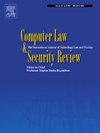Access revisited: AI training at the intersection of copyright and cybercrime laws
IF 3.3
3区 社会学
Q1 LAW
引用次数: 0
Abstract
The rise of generative AI (GenAI) poses urgent questions for copyright law, particularly regarding whether AI training infringes on reproduction rights. Some jurisdictions have tried to reduce these uncertainties through new or existing exceptions. Articles 3 and 4 of European Union Directive 2019/790 and sections 243 and 244 of Singapore’s Copyright Act of 2021 are examples. Both exceptions are subject to the condition of ‘lawful access’. The interpretation of this concept, which is vague and undefined by law, is crucial to these exceptions, as it may, ultimately, deprive them of all usefulness. This paper seeks to unpack the meaning of lawful access and its inverse by drawing on other uses of the concept, namely in cybercrime law, and its underlying values. This analysis points towards an understanding of unlawful access as the circumvention of technological restrictions to access, such as paywalls. However, adopting such measures may reduce the content that is freely available in the digital sphere, thereby impoverishing society and depriving creators of a powerful tool for publicising their works. Finally, the paper considers possible solutions to this problem and their drawbacks.
重新访问:版权和网络犯罪法交叉的人工智能培训
生成式人工智能(GenAI)的兴起对版权法提出了紧迫的问题,特别是关于人工智能训练是否侵犯了复制权。一些司法管辖区试图通过新的或现有的例外来减少这些不确定性。欧盟指令2019/790第3条和第4条以及新加坡《2021年版权法》第243条和第244条就是例子。这两种例外情况都受制于“合法访问”的条件。这一概念在法律上是模糊和未定义的,对这些例外的解释是至关重要的,因为它可能最终剥夺它们的所有用处。本文试图通过借鉴该概念的其他用途(即网络犯罪法)及其潜在价值,来揭示合法访问的含义及其反义。这一分析指向了对非法访问的理解,即绕过对访问的技术限制,如付费墙。然而,采取这些措施可能会减少数字领域中免费提供的内容,从而使社会变得贫穷,并剥夺了创作者宣传其作品的有力工具。最后,本文考虑了解决这一问题的可能方法及其不足。
本文章由计算机程序翻译,如有差异,请以英文原文为准。
求助全文
约1分钟内获得全文
求助全文
来源期刊
CiteScore
5.60
自引率
10.30%
发文量
81
审稿时长
67 days
期刊介绍:
CLSR publishes refereed academic and practitioner papers on topics such as Web 2.0, IT security, Identity management, ID cards, RFID, interference with privacy, Internet law, telecoms regulation, online broadcasting, intellectual property, software law, e-commerce, outsourcing, data protection, EU policy, freedom of information, computer security and many other topics. In addition it provides a regular update on European Union developments, national news from more than 20 jurisdictions in both Europe and the Pacific Rim. It is looking for papers within the subject area that display good quality legal analysis and new lines of legal thought or policy development that go beyond mere description of the subject area, however accurate that may be.

 求助内容:
求助内容: 应助结果提醒方式:
应助结果提醒方式:


